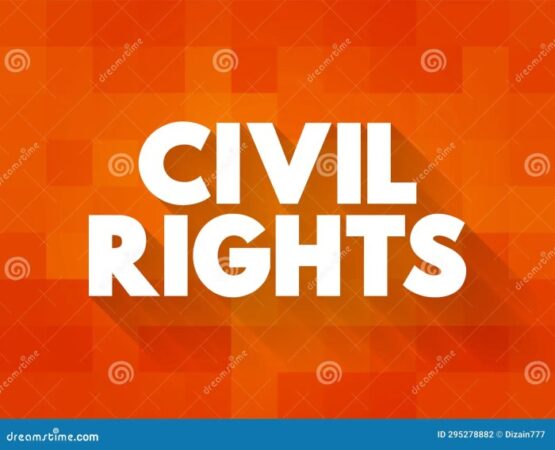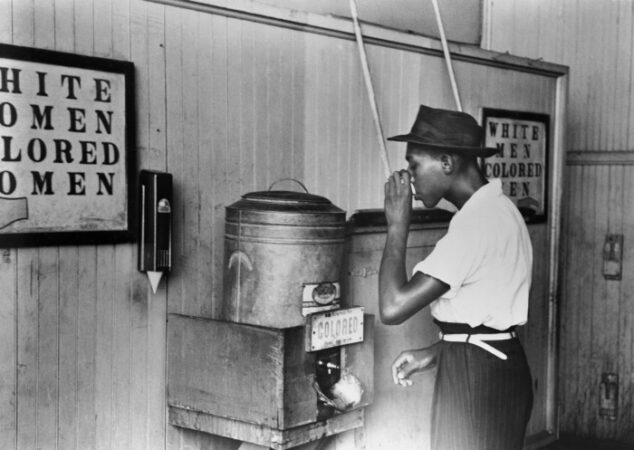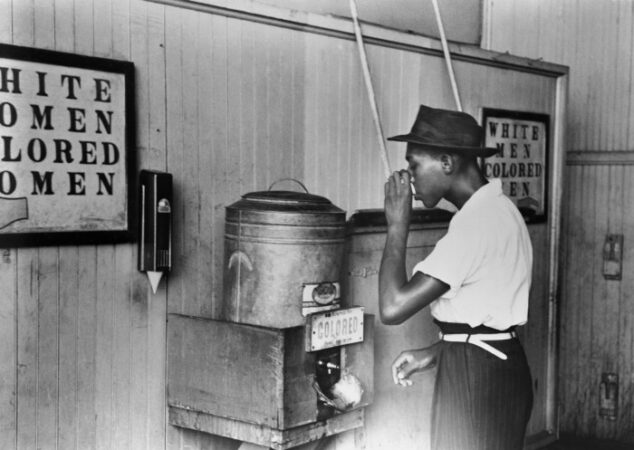
Why were civil rights laws enacted? This question delves into the heart of one of the most significant chapters in American history, a chapter marked by struggle, progress, and enduring challenges. The fight for civil rights in the United States was a long and arduous journey, fueled by the desire for equality and justice for all citizens. The backdrop for this movement was a deeply segregated society where African Americans and other marginalized groups faced systematic discrimination and oppression.
The civil rights movement gained momentum in the mid-20th century, propelled by the tireless efforts of countless individuals and organizations. Events like the Montgomery Bus Boycott, the March on Washington, and the Freedom Rides brought national attention to the injustices faced by African Americans. These acts of courage and resilience, combined with the growing public awareness of the need for change, paved the way for the passage of landmark civil rights legislation.
Historical Context
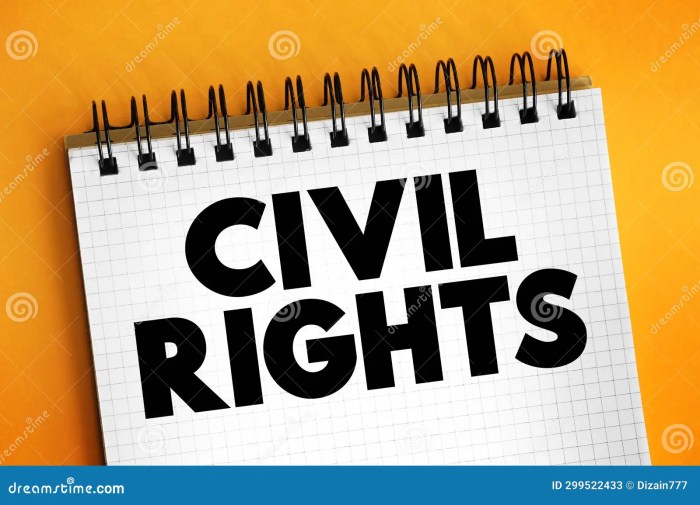
The enactment of civil rights laws in the United States was a culmination of decades of struggle and activism by African Americans and their allies. The social and political climate prior to the passage of these laws was characterized by deeply entrenched racial segregation and discrimination.
The fight for civil rights was rooted in the legacy of slavery and the enduring consequences of racial prejudice. The period following the Civil War, known as Reconstruction, saw some progress in securing rights for African Americans. However, the end of Reconstruction marked a turning point, with the rise of Jim Crow laws and the resurgence of white supremacy.
The Impact of Jim Crow Laws and Segregation
Jim Crow laws, a set of state and local laws enacted in the Southern and some border states, enforced racial segregation and discrimination in virtually all aspects of life. These laws were designed to disenfranchise African Americans and maintain white supremacy.
- Segregation in Public Places: Jim Crow laws mandated separate facilities for blacks and whites, including schools, hospitals, transportation, and public restrooms. These “separate but equal” facilities were often inferior in quality and resources, reflecting the systemic inequality of the era.
- Voting Restrictions: African Americans faced numerous barriers to voting, including literacy tests, poll taxes, and grandfather clauses. These restrictions effectively disenfranchised black voters and ensured white political dominance.
- Economic Disparities: Jim Crow laws and segregation created a system of economic inequality, limiting opportunities for African Americans in employment, housing, and education. This perpetuated a cycle of poverty and disadvantage.
Key Events and Movements
The civil rights movement emerged as a response to the injustices and oppression faced by African Americans under Jim Crow. Several key events and movements contributed to the rise of the movement, galvanizing public opinion and fueling the demand for change.
- The Brown v. Board of Education Decision (1954): This landmark Supreme Court ruling declared that racial segregation in public schools was unconstitutional, striking a blow against the foundation of Jim Crow. The decision sparked hope and inspired a new wave of activism.
- The Montgomery Bus Boycott (1955-1956): This boycott, led by Rosa Parks and Martin Luther King Jr., protested the segregation of public transportation in Montgomery, Alabama. The boycott lasted for over a year and ultimately led to the desegregation of buses in the city. It served as a powerful example of nonviolent resistance and inspired similar protests across the country.
- The Civil Rights Act of 1964: This landmark legislation outlawed discrimination based on race, color, religion, sex, or national origin. It prohibited segregation in public facilities, employment discrimination, and voting discrimination. The Civil Rights Act was a major victory for the movement, marking a turning point in the struggle for equality.
- The Voting Rights Act of 1965: This act outlawed discriminatory voting practices, including literacy tests and poll taxes, that had been used to disenfranchise African Americans. It also established federal oversight of elections in areas with a history of voting discrimination. The Voting Rights Act significantly increased African American voter registration and participation.
Key Legislation
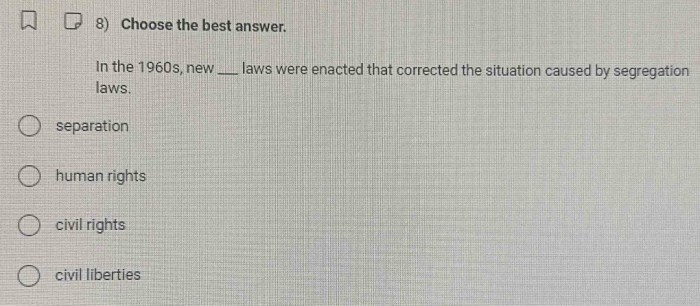
The fight for civil rights in the United States was long and arduous, marked by significant legal battles and social movements. The passage of key federal civil rights laws in the mid-20th century played a pivotal role in dismantling segregation and discrimination, transforming American society. These laws, enacted during a period of immense social and political change, aimed to guarantee equal rights and opportunities for all citizens, regardless of race, color, religion, sex, or national origin.
The Civil Rights Act of 1964
The Civil Rights Act of 1964 was a landmark piece of legislation that outlawed discrimination based on race, color, religion, sex, or national origin. It prohibited discrimination in public accommodations, employment, education, and voting. The act was a culmination of years of activism and advocacy by civil rights organizations and individuals. It was a major victory for the civil rights movement, but its implementation and enforcement faced challenges.
The Voting Rights Act of 1965
The Voting Rights Act of 1965 was another pivotal piece of legislation that aimed to eliminate racial discrimination in voting. It outlawed literacy tests and other discriminatory practices used to prevent African Americans from registering to vote. The act also authorized federal oversight of elections in areas with a history of voting discrimination. This law had a profound impact on African American political participation, leading to a significant increase in voter registration and representation in government.
The Fair Housing Act of 1968
The Fair Housing Act of 1968, also known as the Civil Rights Act of 1968, prohibited discrimination in the sale, rental, and financing of housing based on race, color, religion, sex, or national origin. It was passed in the aftermath of the assassination of Martin Luther King Jr., and it aimed to address the widespread housing discrimination faced by African Americans. This act aimed to ensure equal access to housing opportunities for all Americans, but its implementation and enforcement faced challenges.
Social and Political Factors
The enactment of civil rights laws was not solely a product of legislative maneuvering. It was deeply intertwined with the evolving social and political landscape of the United States. The persistent efforts of civil rights activists, the growing public awareness of racial injustice, and the federal government’s response to the movement’s demands all played crucial roles in shaping the course of legislation.
Public Opinion and Activism, Why were civil rights laws enacted
The civil rights movement was fueled by a growing public awareness of racial discrimination and segregation. Activists used various methods, such as sit-ins, marches, and boycotts, to draw attention to the injustices faced by African Americans. These actions often led to violence and arrests, but they also generated widespread media coverage and public sympathy. The movement’s tactics helped to shift public opinion, putting pressure on lawmakers to address the issue of racial inequality.
Key Figures and Organizations
Several prominent figures and organizations played pivotal roles in advancing the civil rights movement. Martin Luther King Jr., with his philosophy of nonviolent resistance, became a symbol of the movement’s moral authority. The NAACP, founded in 1909, provided legal support and advocacy for African Americans, challenging discriminatory laws in court. The Student Nonviolent Coordinating Committee (SNCC) mobilized young activists, particularly in the South, to organize protests and voter registration drives. These organizations, along with others, helped to galvanize the movement, drawing attention to its demands and mobilizing public support.
The Federal Government’s Response
The federal government’s response to the civil rights movement was initially hesitant, but it gradually became more assertive. President John F. Kennedy, facing increasing pressure from activists and public opinion, introduced a civil rights bill in 1963. However, the bill faced strong opposition in Congress. After Kennedy’s assassination, President Lyndon B. Johnson pushed for the passage of the Civil Rights Act of 1964, which outlawed discrimination based on race, color, religion, sex, or national origin. This landmark legislation, along with the Voting Rights Act of 1965, represented a significant shift in the government’s commitment to protecting civil rights.
Impact and Legacy
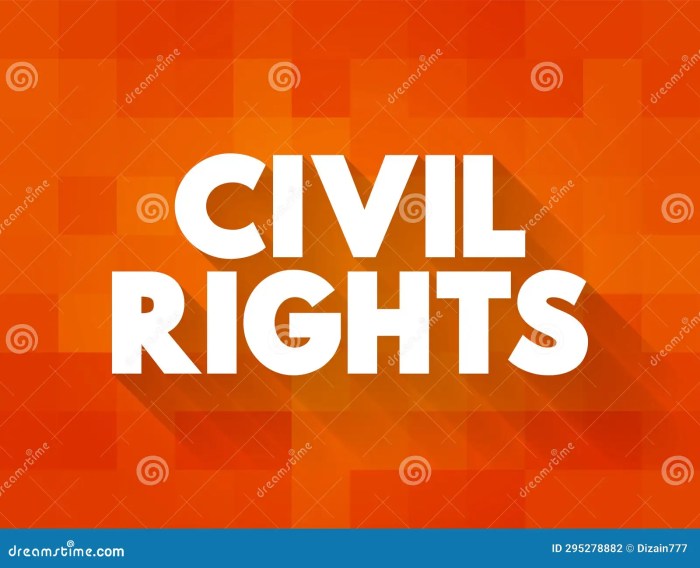
The Civil Rights Act of 1964 and the Voting Rights Act of 1965, along with other landmark legislation, ushered in a new era for African Americans and other marginalized groups in the United States. These laws had a profound impact on the lives of millions, leading to significant changes in education, employment, housing, and political participation.
Transformations in American Society
The Civil Rights Act of 1964 outlawed discrimination based on race, color, religion, sex, or national origin. This legislation had a dramatic impact on the lives of African Americans, particularly in the South. Segregation in public places, such as restaurants, hotels, and theaters, was abolished, and African Americans gained greater access to employment opportunities.
The Voting Rights Act of 1965 prohibited discriminatory voting practices, such as literacy tests and poll taxes, which had been used to disenfranchise African Americans for decades. This law led to a significant increase in African American voter registration and participation in the political process.
- Increased Educational Opportunities: Desegregation of schools, mandated by the Supreme Court’s 1954 Brown v. Board of Education decision, and subsequent legislation, led to greater access to quality education for African American children. This resulted in higher graduation rates, increased college enrollment, and greater access to professional careers.
- Economic Advancement: The Civil Rights Act opened doors to employment opportunities previously denied to African Americans. This led to a rise in the black middle class and greater economic security for many families.
- Political Empowerment: The Voting Rights Act dramatically increased African American voter registration and participation in elections. This led to the election of more African American officials at all levels of government, including the U.S. Congress and state legislatures.
Ongoing Challenges
Despite the progress achieved, the fight for full equality and justice continues. Ongoing challenges include:
- Systemic Racism: Systemic racism persists in many areas of American society, including criminal justice, education, and housing. This manifests in racial disparities in arrests, sentencing, school funding, and access to quality housing.
- Economic Inequality: The wealth gap between white and black Americans remains significant. African Americans continue to face higher rates of poverty, unemployment, and underemployment.
- Police Brutality and Racial Profiling: African Americans are disproportionately targeted by police and are more likely to be subjected to excessive force and racial profiling. This issue has led to widespread protests and calls for police reform.
- Access to Healthcare: African Americans continue to experience disparities in access to quality healthcare, resulting in higher rates of chronic diseases and shorter life expectancies.
The Lasting Legacy
The Civil Rights Movement and the landmark legislation that resulted from it have left an enduring legacy on American society. The movement inspired generations of activists and continues to serve as a model for social justice movements around the world.
- Increased Awareness of Social Justice Issues: The Civil Rights Movement brought national attention to the injustices faced by African Americans and other marginalized groups. This awareness led to a broader understanding of social justice issues and a growing commitment to equality and fairness.
- Inspiration for Other Social Movements: The Civil Rights Movement served as a model for other social movements, including the women’s rights movement, the LGBTQ+ rights movement, and the disability rights movement. It demonstrated the power of nonviolent resistance and the importance of organizing and mobilizing for social change.
- Expansion of Democracy: The Civil Rights Movement and the subsequent legislation expanded the definition of democracy in the United States. It affirmed the principle that all citizens, regardless of race or ethnicity, deserve equal rights and opportunities.
Final Review: Why Were Civil Rights Laws Enacted
The legacy of the civil rights movement is woven into the fabric of American society. The laws enacted during this era have significantly transformed the lives of millions, opening doors to opportunity and ensuring greater equality. However, the fight for full equality is not over. Despite the progress made, systemic racism and discrimination persist in various forms, reminding us that the work of achieving justice is ongoing. The civil rights movement serves as a powerful reminder of the importance of perseverance, unity, and the unwavering pursuit of a more just and equitable society.
User Queries
What specific events sparked the civil rights movement?
The civil rights movement was ignited by a number of key events, including the Brown v. Board of Education Supreme Court ruling in 1954, which declared segregation in public schools unconstitutional, and the Montgomery Bus Boycott of 1955-1956, which was sparked by the arrest of Rosa Parks for refusing to give up her seat on a bus to a white man.
What were the main goals of the civil rights movement?
The primary goals of the civil rights movement were to end segregation, achieve equal voting rights, and secure economic and social equality for African Americans. The movement also aimed to address discrimination against other marginalized groups, including women, Latinos, and Native Americans.
How did the civil rights movement impact the lives of African Americans?
The civil rights movement brought about significant changes in the lives of African Americans. The passage of civil rights legislation led to the desegregation of schools, public facilities, and workplaces. It also granted African Americans the right to vote and increased their access to education, housing, and employment opportunities.
